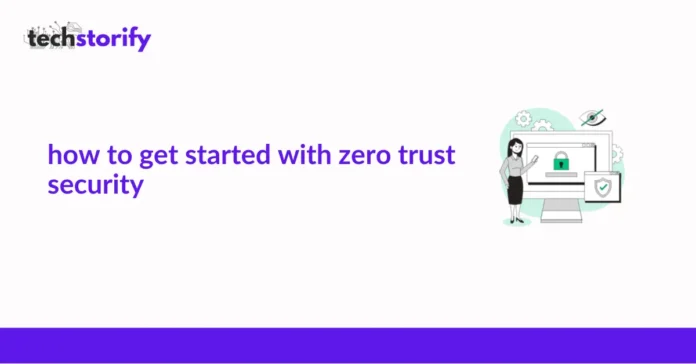The Zero Trust Security model eliminates any concept of trust regarding network security. The model assumes that every actor in an IT network is suspicious until proven otherwise. The Zero Trust security model ensures that only authorized traffic is allowed onto the network. Therefore, it strictly monitors the traffic coming onto the network.
A policy of least privilege exercises strict access control to limit security risks. The fundamental tenets of the Zero Trust model involve cutting off all connections, eliminating the attack surface to reduce risk, and applying granular context-based policies to data protection.
Contents
- Implementing the Zero Trust Security Model
- Step 1: Assess your environment and rally a dedicated team
- Step 2: Review the available technology and define your protect surfaces
- Step 3: Identify processes and build micro-perimeters
- Step 4: Define operational changes and create security policies
- Step 5: Deploy the framework and enforce security policies
- Step 6: Monitor and expand the framework
- Conclusion
Implementing the Zero Trust Security Model
The Zero Trust Security Model provides numerous security benefits to business organizations, including continuous monitoring and verification, device access management, microsegmentation, restriction of lateral movement, and multi-factor authentication (MFA). It can almost be considered a necessity based on the granularity it provides to your system. This ensures improved security and protection of sensitive data against cyber threats. This article will provide step-by-step guidance on how an organization can get started with Zero Trust Security.
Step 1: Assess your environment and rally a dedicated team
The first step in Zero Trust Security implementation is visualizing your network entities and their relationships. You must assess and classify all the users, applications, devices, resources, and data connected to your network. You need to identify your company’s security maturity level and skill set before creating an infrastructure for Zero Trust. At this point, it is important to identify any critical interdependencies in applications so that you don’t make any mistakes while segmenting our network later.
The proper implementation of Zero Trust requires participation from all the departments in an organization. Support from top leadership and stakeholders is crucial. While deciding on a team for Zero Trust implementation, ensure to include members from network security, access management, change management, and applications and data security.
Step 2: Review the available technology and define your protect surfaces
Protect surface refers to one unit behind a micro-perimeter of security controls. It is composed of different resources grouped into a network segment. A catalog of all the individual resources and network data, applications, assets, and services (also known as DAAS) that are a part of your network must be maintained. These may include digital artifacts, enterprise-owned hardware, and assets regularly connecting to enterprise resources. This ensures a systematic implementation of policies and tools across your IT network. Defining the attack surface is one of the most crucial steps in implementing Zero Trust.
Some categories in which digital assets may be classified include sensitive data, critical applications, physical assets, and corporate services. Once protect surfaces are identified, you need to decide the specific security measures and technology that may be required to secure them. According to The National Institute of Standards and Technology (NIST), the three main approaches to implementing a Zero Trust Architecture (ZTA) are microsegmentation, software-defined perimeter, and Enhanced Identity Governance (IAM and PAM).
Step 3: Identify processes and build micro-perimeters
Once the protect surfaces are identified, the next step is to identify and catalog the processes with respect to cybersecurity needs. The processes may be classified into protocols, data flows, workflows, structured events, and transactions. You will further need to revamp your reporting, identity access, authentication, and communications in your company. Once done, now is the time to establish micro-perimeters to secure each segment.
In the Zero Trust model implementation, micro-perimeters are the targeted security controls that protect each network segment/protect surface. Considering that these segments are smaller, they give you better control to manage access to individual resources. You may use firewalls to create micro-perimeters and enforce access control policies.
Step 4: Define operational changes and create security policies
Zero Trust implementation requires significant changes in your security operations. For example, many tasks that are handled manually in the company may need to be automated or modified to prevent gaps in security. To ensure the flawless modification of the processes, your organization will need disciplined change management practices. Various solutions are drafted that are guided by security policies.
Any task that may fall out of the sequence may create security gaps. All the department heads should be kept in the loop as the operational changes are being decided. Now that you have defined your protect surfaces, established your micro-perimeters, and communicated your operational changes, you will need to create precise security policies.
These policies will be created considering the principle of least privilege, ensuring that users only get enough access to carry out their jobs. For instance, a reporter working from home only needs remote access to apps like Zoom, Outlook, and Office 365. Using precise security policies and PoLP, access to all other applications in the enterprise network will be restricted.
Step 5: Deploy the framework and enforce security policies
Once the Zero Trust framework is deployed, you need to assess its value according to security key performance indicators (KPIs), including the average time to contain incidents. This is the stage where actual changes are implemented to your IT framework.
Considering the risks involved in this step, it is recommended that you test the framework with one or more trial runs before ultimately deploying the solution in full force. There is a big chance the system might not handle special cases properly. Zero Trust Architecture components are not deployed until all components are operating seamlessly.
Step 6: Monitor and expand the framework
To obtain valuable insights for optimizing network performance without compromising security, you must constantly monitor the reports, analytics, and logs. The initial issues should be corrected immediately, and there should be strict monitoring to identify any potential problems. These problems and solutions will guide your decisions as you move toward the next step.
Before expanding the implementation, you should ensure that the traffic is logged and the operation involves little or no maintenance. Now that the initial Zero Trust architecture is functional and stable, the implementation team should focus on spreading the successful Zero Trust architecture throughout the rest of your company.
Conclusion
Zero Trust security framework works on the principle that companies shouldn’t trust any device or person by default, whether inside or outside their perimeters. Your ultimate goal in implementing the Zero Trust practices is that your entire cybersecurity framework and company should be enveloped in your Zero Trust Architecture. This architecture disables all access points until sufficient validation, and mutual trust has been achieved. A network access control (NAC) system is the most part of the Zero Trust framework implementation. Click here to learn more about Zero Trust Security, its requirements, use cases, examples, and alternative solutions.




![How to Solve [pii_email_fac20b28ca7fd86484f1] Error Code How to Solve [pii_email_fac20b28ca7fd86484f1] Error Code](https://techstorify.com/wp-content/uploads/2022/01/How-to-Solve-pii_email_fac20b28ca7fd86484f1-Error-Code-218x150.png)









